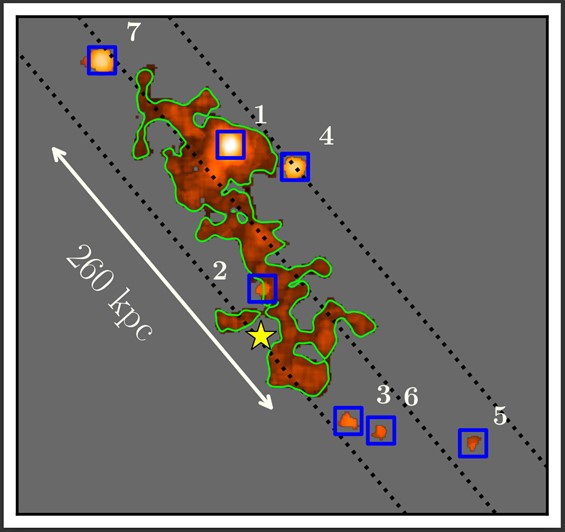Ministry of Science & Technology
Unveiling the Universe’s Hidden Threads: Indian Astronomers Discover a Cosmic Web Filament from 11.7 Billion Years Ago
Posted On:
30 JAN 2025 4:15PM by PIB Mumbai
Mumbai, 30 January 2025
Galaxies are the fundamental building blocks of the universe. Modern galaxy evolution theories predict that galaxies are interconnected by vast, invisible streams of gas and dark matter, collectively referred to as the cosmic web. These cosmic web filaments serve as the nurseries where galaxies grow by accreting pristine gas that fuels their star formation. However, observing these filaments has been a daunting challenge because of their tenuous nature with densities 100 billion trillion times lower than our atmosphere.
Recently, a team of international scientists led by Ms. Eshita Banerjee, a PhD scholar at the Inter University Centre for Astronomy & Astrophysics (IUCAA), and her supervisor Dr. Sowgat Muzahid, has discovered a giant cosmic web filament stretching nearly 850,000 light-years by analyzing light emitted 11.7 billion years ago. To put this in perspective, this length compares to roughly 10 times the size of the Milky Way’s stellar disk and one-third of the distance between the Milky Way and our nearest neighbor, Andromeda. The discovery was made possible using the Very Large Telescope (VLT) in Chile, operated by the European Southern Observatory (ESO).
To detect this elusive structure, the researchers directed their telescope toward the high-redshift quasar Q1317–0507. By analyzing the high-resolution spectra of the quasar, they identified a neutral hydrogen-rich region, known as a partial Lyman Limit System (pLLS), at a redshift of z ~ 3.6. This region exhibited an exceptionally low proportion of heavy elements, with a metallicity 10,000 times lower than the solar neighborhood, aligning with theoretical predictions for pristine cosmic filaments. In complementary observations with the Multi-Unit Spectroscopic Explorer (MUSE) on the VLT, the team identified seven Lyman-alpha emitting galaxies at the same redshift. “The number of galaxies detected in such a small volume of the universe is ten times higher than what we typically observe in surveys at this epoch,” said Eshita Banerjee.“ Moreover, their spatial distribution across the sky revealed a rare alignment, which strongly suggests the presence of a larger, underlying filamentary structure. The 10-hour-long deep observations with MUSE, one of the most sought-after instruments for astronomers, enabled us to search for and detect extended Lyman-alpha emission along the filamentary structure,” she added.
“These nebulae are typically observed around luminous quasars, whose intense radiation illuminates the surrounding gas. However, none of the galaxies detected in this study exhibit quasar-like properties, making this discovery truly exceptional,” stated Dr. Sowgat Muzahid, an associate professor at IUCAA. “While the precise mechanism(s) driving the extended Lyman-alpha emission remains unclear, we propose that recombination radiation, powered by the radiation fields of the detected galaxies, is the primary contributor,” he added.
The research team has effectively demonstrated the unique power of combining complementary information on cosmic web filaments through both emission and absorption line studies for the first time. Absorption line studies offer crucial insights into the primordial nature of filaments detected in emission. This synergistic approach renders this study distinctive. Over time, this pristine gas in the filament is expected to flow into these galaxies, fueling new star formation and shaping their evolution. This research was recently accepted by the prestigious Astrophysical Journal Letters ( https://iopscience.iop.org/article/10.3847/2041-8213/ada94f)
“This discovery not only highlights the capabilities of modern observational facilities but also demonstrates the importance of international collaborations that enabled us to leverage the ESO facilities,” said Dr. Muzahid. The research was conducted in collaboration with scientists from Leiden University (Netherlands), University of Milan-Bicocca (Italy), and the University of Michigan (USA).

(The seven galaxies, highlighted in blue boxes, detected with MUSE exhibit a striking linear alignment, indicating an underlying filamentary structure. This alignment is remarkably mirrored by a 260-kpc-long Lyman-alpha nebula emanating from the giant filament. The yellow star pinpoints the location of the background quasar, whose light served as a probe to measure the metallicity of the filament, confirming its primordial nature.)
* * *
(Source: IUCAA) | PIB Mumbai | NJ/ ST/DR
Follow us on social media: @PIBMumbai
@PIBMumbai  /PIBMumbai
/PIBMumbai  /pibmumbai
/pibmumbai  pibmumbai[at]gmail[dot]com
pibmumbai[at]gmail[dot]com  /PIBMumbai
/PIBMumbai  /pibmumbai
/pibmumbai
(Release ID: 2097620)
Visitor Counter : 101